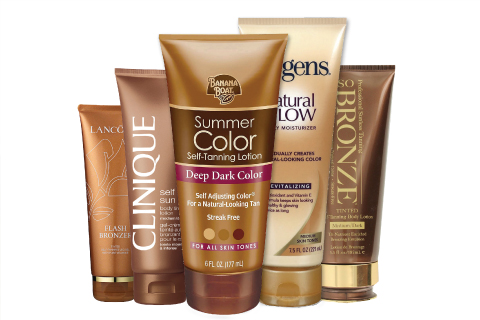Seven Tips for Applying Sunless Tanner

If you’ve been outside these last months, chances are that, despite slathering on the sunscreen, you’ve developed some tan lines. Although you may be proud of the cycling you’ve been doing, the running miles logged, all those tennis matches played, and lengths upon lengths swum in the pool, you may not be happy about the paler areas you’ve developed. Or, perhaps you’ve been in the gym avoiding the heat and haven’t gotten quite the glow you’d like. Here are seven tips for adding color when you want, without sun exposure.
Start out by exfoliating and moisturizing.
It’s important to prep your skin prior to applying sunless tanner. Exfoliating removes dead skin cells so that you don’t wind up with splotchy areas when that surface skin sloughs off. Moisturizing evens out your skin so that the tanning spray or lotion is uniformly absorbed (you’d hate to have darker areas where skin is typically dry, such as elbows, knees, and ankles). You can also wipe these areas gently with a damp towel to avoid product build-up while you apply.
Avoid streaks by choosing an opaque product.
“One of the biggest problems people experience when they use self-tanning products is streaking and unevenness,” said Toni Brattin, an entrepreneur with a line of self-tanning products called Tan Secret). “That’s because many of the tanning creams and lotions have no color or a very light color, so you have to sit and wait—sometimes for hours—to see if the product was evenly applied or whether you missed an area entirely.” One way around this issue is to choose a product that has a darker pigment (Brattin actually sells a self-tanning foam that looks like a rich, chocolate mousse so that users can see how they’re applying). “Adding dark pigment to the formulation has two benefits,” she explained. “First, it gives [users] the ability to see that the product is being evenly dispersed on the skin, so they are confident they won’t end up with a streaky mess or looking like a zebra. Second, the pigment gives…a little bit of instant tan coloring on their skin.”
Bypass problems with spot testing.
Yes, you may delay some of that instant gratification but it’s worth your while to try a test application of a new chemical product on a small area, especially if you have sensitive skin. If you’d prefer not to look pale, you’d probably prefer not to look rashy, either. Do note that, according to the Mayo Clinic, sunless tanning pills, which typically contain the color additive canthaxanthin, are unsafe and “can turn your skin orange or brown and cause hives, liver damage, and impaired vision” when taken in large quantities—so don’t even go there.
Check out that smell.
No one wants to be covered in an unsightly rash…or in chemicals that produced an unpleasant smell. “The active ingredients that cause tanning to occur, dihydroxyacetone and erythrulose, are chemicals with very unpleasant odors,” said Brattin. “Many times [people apply] a tanning product only to later discover that the chemical odor left on their skin remains so strong that they can’t comfortably go out in public, even after showering.” Brattin went on to explain that some of the “better quality” products avoid this problem through their formulas, but you should still test to make sure your product produces a scent you can live with for a few days.
Practice patience with your application.
Read the directions on your tanner carefully to determine the drying time required. The last thing you need is to find out you’ve put on your favorite white shirt only to discover later that your sunless tanner wasn’t quite dry. Wait at least ten minutes to dress, wear loose clothing, and avoid sweating for three hours after application.
Think about where you’re spraying…and rubbing.
Sure, that spray-on tan may look easy but think carefully before you point and shoot; those particles that don’t make it onto your body are going to self-tan something else (your carpet, furniture, walls). For that reason, think about applying that spray outside. Also consider that you may inhale those particles, which, in addition to being irritating, could be harmful to your health (the FDA has not approved dihydroxyacetone for application to areas near the eyes, mouth, or nose, so be careful and hold your breath!). If you prefer, you can also wear the simple paper masks that protect you from inhaled particles, such as flu germs, which are available at most drug stores.
If you’re using a lotion, think a minute about your bare hands. Prolonged contact could provide some very dark palms. Check to see if your product provides an applicator wand or gloves. You can also apply in sections, making sure to wash your hands after you’ve finished with each area to avoid build-up.
Consider seeing a professional.
Although it’s entirely possible to get a great looking glow, not everyone is a DIYer. There are numerous salons that provide sunless tanning options by professionals who practice day in and day out.






